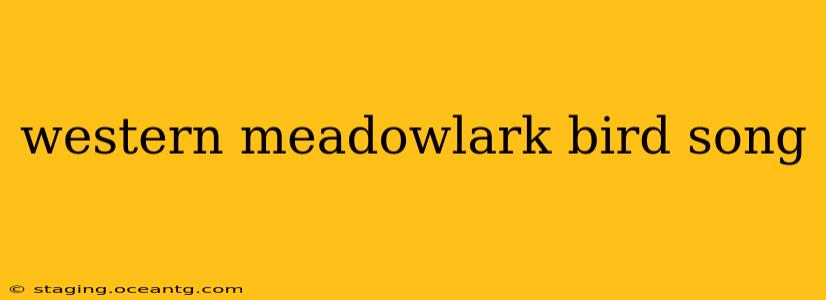The Western Meadowlark ( Sturnella neglecta ) is more than just a pretty bird; its song is a defining characteristic of the American West. This cheerful, melodic tune, often described as a bubbling, flute-like sound, is instantly recognizable to anyone who has spent time in the grasslands, prairies, and open fields where this iconic bird resides. But what makes this song so unique, and what can we learn about the Western Meadowlark through its vocalizations? Let's delve into the fascinating world of the Western Meadowlark's song.
What does a Western Meadowlark's song sound like?
The Western Meadowlark's song is arguably its most striking feature. It's a complex, musical performance, often described as a series of clear, whistled notes with a distinct bubbling quality. The song typically starts with a few introductory notes, followed by a longer, more elaborate melody. It often includes a descending scale-like sequence, culminating in a final, slightly drawn-out note. Think of a cheerful, slightly melancholic tune, perfect for a sunny afternoon on the prairie. The variation in individual songs is remarkable, with each bird possessing its own unique "dialect."
How does the Western Meadowlark's song differ from the Eastern Meadowlark?
While both species share similarities, their songs are distinct enough to be easily differentiated by experienced birders. The Eastern Meadowlark (Sturnella magna) possesses a song that is generally considered more melodious and less "bubbly" than its western counterpart. The Eastern Meadowlark's song tends to be more drawn-out and less varied in its phrasing. The key difference lies in the overall quality and structure of the melody; the Western Meadowlark's song often has a more rapid, slightly faster tempo.
How is the Western Meadowlark's song used for communication?
The Western Meadowlark's song serves several crucial communication purposes:
- Territory Defense: The song is primarily used to establish and defend territories, particularly during the breeding season. Males sing prolifically to advertise their presence and warn off rival males.
- Mate Attraction: The complex and varied nature of the song is also a key factor in attracting females. A male with a strong, varied song is more likely to attract a mate.
- Individual Recognition: Although the basic structure of the song is similar across individuals, subtle variations within the song allow birds to recognize each other and their neighbors.
What is the purpose of the Western Meadowlark's song?
As mentioned above, the primary function of the Western Meadowlark’s song is territorial defense and mate attraction. The intricate melody serves as a powerful signal, broadcasting the male's fitness and territorial claims across the grasslands. The more complex and varied the song, the more attractive the male is to potential mates.
How far can you hear a Western Meadowlark's song?
The carrying power of the Western Meadowlark’s song is remarkable. On a clear day, their songs can be heard from a considerable distance, often exceeding a quarter-mile, depending on the terrain and environmental conditions. This long-range vocalization is essential for communication across their expansive territories.
What time of year is the Western Meadowlark most vocal?
The Western Meadowlark is most active in singing during the breeding season, typically from spring to early summer. This period coincides with their territorial defense and mate attraction activities. While they may sing sporadically throughout the year, their vocalizations are most frequent and intense during the breeding season.
Can Western Meadowlarks learn new songs?
While the basic structure of the Western Meadowlark's song is innate, there's evidence suggesting a degree of learned vocalization. Young birds may refine their songs through imitation and interaction with other birds, particularly their fathers. This learned component contributes to the variation observed in individual songs.
In conclusion, the Western Meadowlark's song is a captivating blend of innate and learned behavior, a complex auditory tapestry that reflects the bird's ecology, social dynamics, and evolutionary history. Its unique melody not only identifies this remarkable bird but also paints a vivid sonic portrait of the American West.
